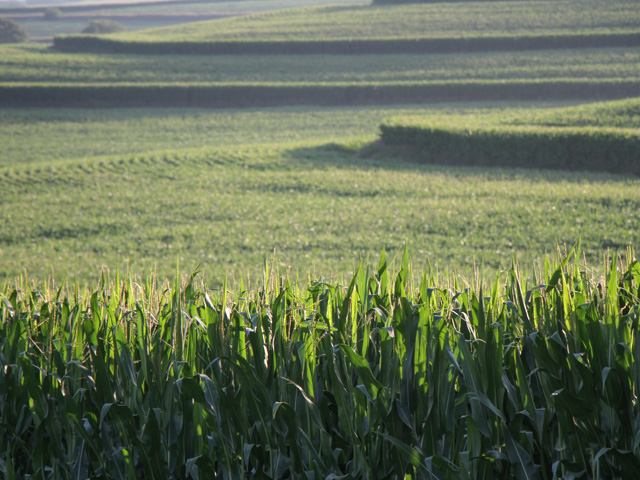Climate, Agronomics Boost Corn Yields
Nebraska Study Finds Agronomics, Climate Drive Higher Corn Yields, Not Genetics
LINCOLN, Neb. (DTN) -- Climate trends and agronomic improvements were the overwhelming factors leading to higher corn yields on farmland in Nebraska from 2005 to 2018, while improvements in genetic traits accounted for a small percentage of yield gains, a new study by the University of Nebraska found.
Most yield studies have focused largely on improvements in corn genetics as a reason for growing yields, as well as reason for hope in feeding a growing world population.
The findings were published in the latest Proceedings of the National Academy of Sciences, by scientists in the department of agronomy and horticulture, as well as the department of statistics at Nebraska.
"The fact that these findings were so different from most previous studies, which gave much-greater weight to genetic yield potential improvement, gives urgency to the need to reevaluate contributions to yield advances for all major food crops to help guide future investments in research and development to achieve sustainable global food security," the study said.
"If genetic progress in yield potential is also slowing in other environments and crops, future crop-yield gains will increasingly rely on improved agronomic practices. Demographic, economic and dietary trends will require substantial increases in yields of staple grain crops on existing production area to avoid conversion of natural ecosystems to farmland. However, there is evidence of slowdown in yield gains and even yield plateaus in some high-yield cropping systems of the world, including rice in China and California (United States) and wheat in northwestern Europe."
YIELD GAINS ATTRIBUTED TO CLIMATE
Scientists conducting the study relied on a large farmer-reported database, "high-quality" weather and management practices data and "robust" crop simulation.
The information comes from a database maintained by Natural Resource Districts in Nebraska. The information used for the study includes field-level data on yield and applied inputs in three NRDs including the Lower Niobrara, Tri-Basin and Upper Big Blue.
P[L1] D[0x0] M[300x250] OOP[F] ADUNIT[] T[]
"We found that nearly half the yield gain from 2005 to 2018 was attributable to a favorable climate trend during this period," the study said.
"In addition, our analysis estimates a technology-driven yield gain associated with widespread adoption of agronomic technologies and improved hybrids, accounting for the other half of total yield gain. We view this finding with optimism, because others have found strong evidence of yield plateaus and negative impact of climate change on U.S. maize yield.
"However, from a global perspective, the technology-driven yield gain estimated for irrigated maize in Nebraska is only half of the global rate of yield gain for maize during the same time period (2005 through 2018)."
The study said the finding was consistent with the notion of yield gains becoming more difficult to achieve in cropping systems where average farm yield is near yield potential, as is the case for irrigated corn in the U.S.
Genetic improvement in corn-yield potential accounted for just 13% of the total yield gain in the study.
"The contribution of genetic technologies found here is three to four times smaller than that reported in previous studies for well-watered maize grown at optimal plant density, ranging from 0.60 to 0.83% (per acre)," the study said.
"Our estimate of genetic yield potential gain may be inflated, as it includes contributions from insect- and herbicide-resistance traits, which may have helped to increase farm yields but not yield potential per se."
Researchers said the study shows previous predictions of sharp increases in corn-yield potential with the advent of biotechnology and molecular techniques, have fallen short of reality.
"Indeed, we found the rate of genetic gain in maize yield potential to be less than a third of the yield gain due to management, suggesting that the rate of yield increase of maize grown in favorable environments will slow markedly over coming decades," the study said.
"This finding is of particular concern, considering that investment in maize genetic-improvement research and development in the public and private sector has been considerably larger than that for other crops. If similar trends are occurring in the other major staple food grains, as it has been reported for rice and wheat, opportunities to increase yields on existing farmland in irrigated and favorable rainfed environments will more likely come from increased cropping intensity (more crops per year) rather than higher yields per crop and especially so when global-warming trends are considered."
The study said caution should be taken in using recent crop yield trends to estimate future food production potential without correction for recent climate trends, "because doing so can give misleading estimates of global capacity to meet future food demand on existing cropland."
In addition, the study said the rate of yield-potential gain from adoption of new technologies is "below that needed" to meet maize demand on existing land by 2050.
"If these trends persist over the long term, future production gains will rely on increasing yields in areas where current yields are well below their potential or from further expansion of cropland area at expense of natural ecosystems, highlighting the importance of raising crop yield potential to meet future food demand and reduce associated land and water requirements," the study said.
Read the study here: https://www.pnas.org/…
Todd Neeley can be reached at todd.neeley@dtn.com
Follow him on Twitter @DTNeeley
(c) Copyright 2022 DTN, LLC. All rights reserved.



